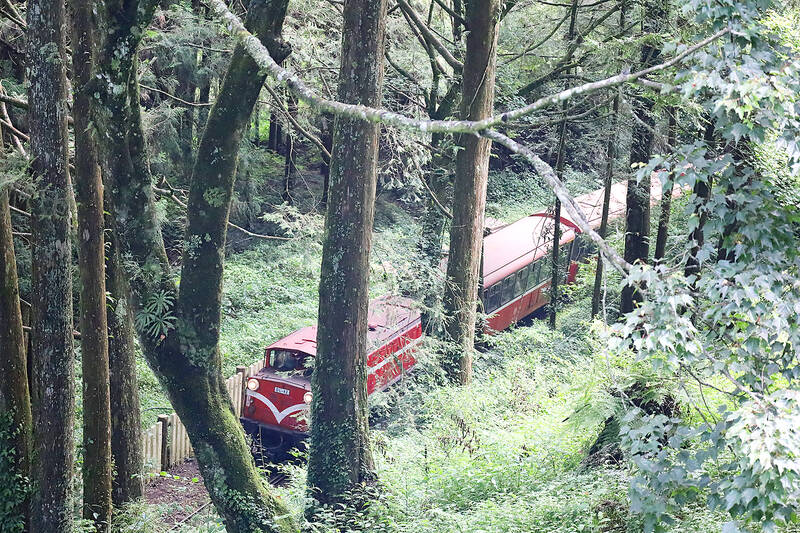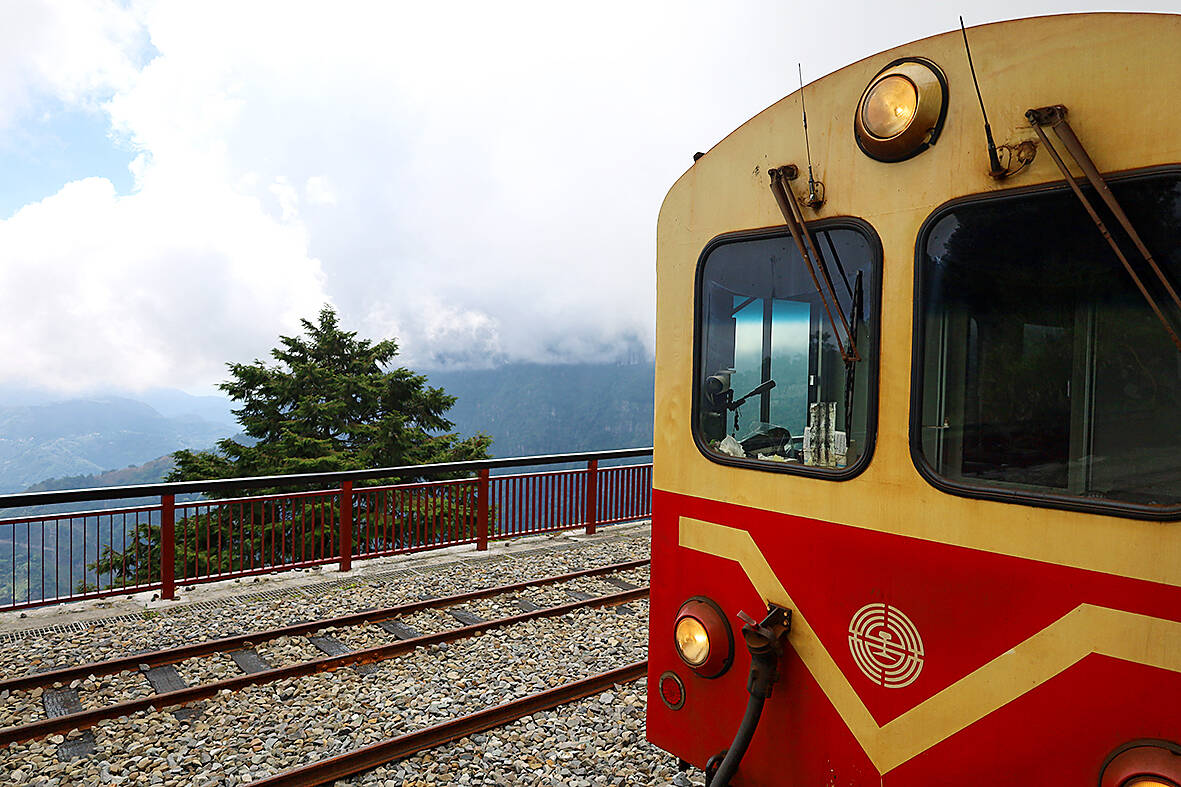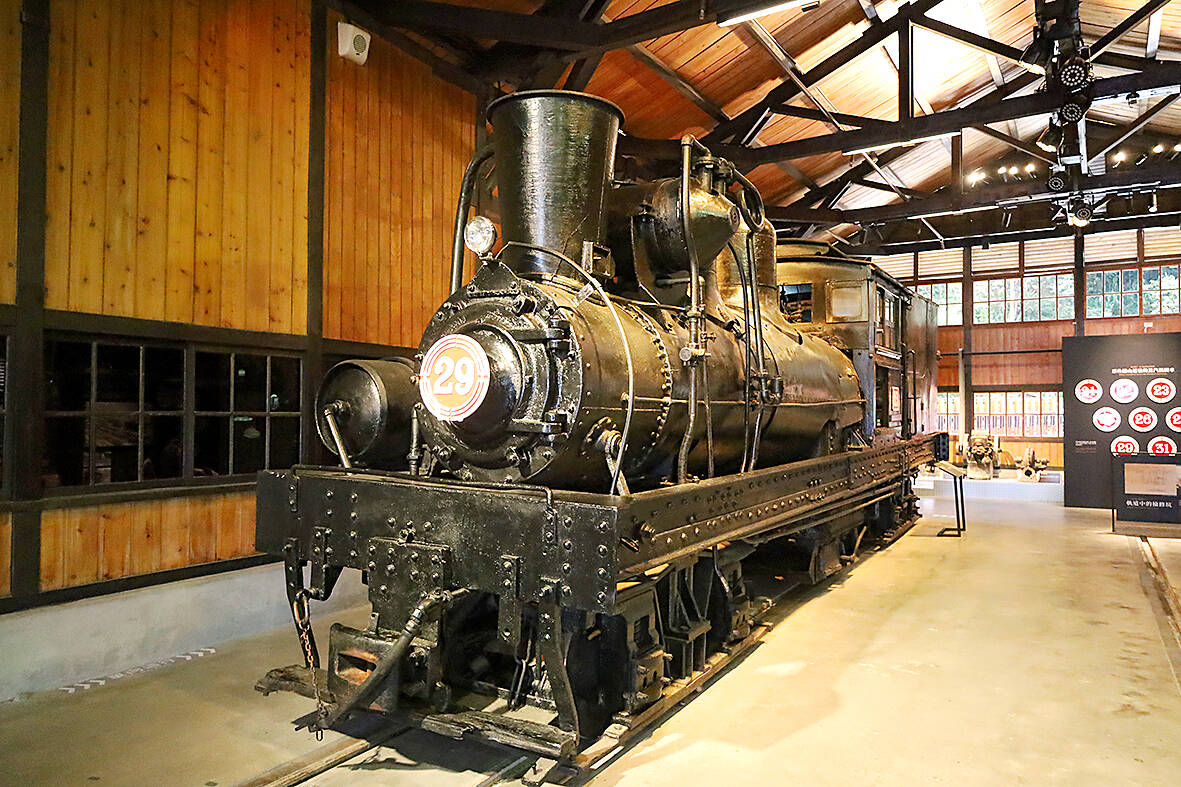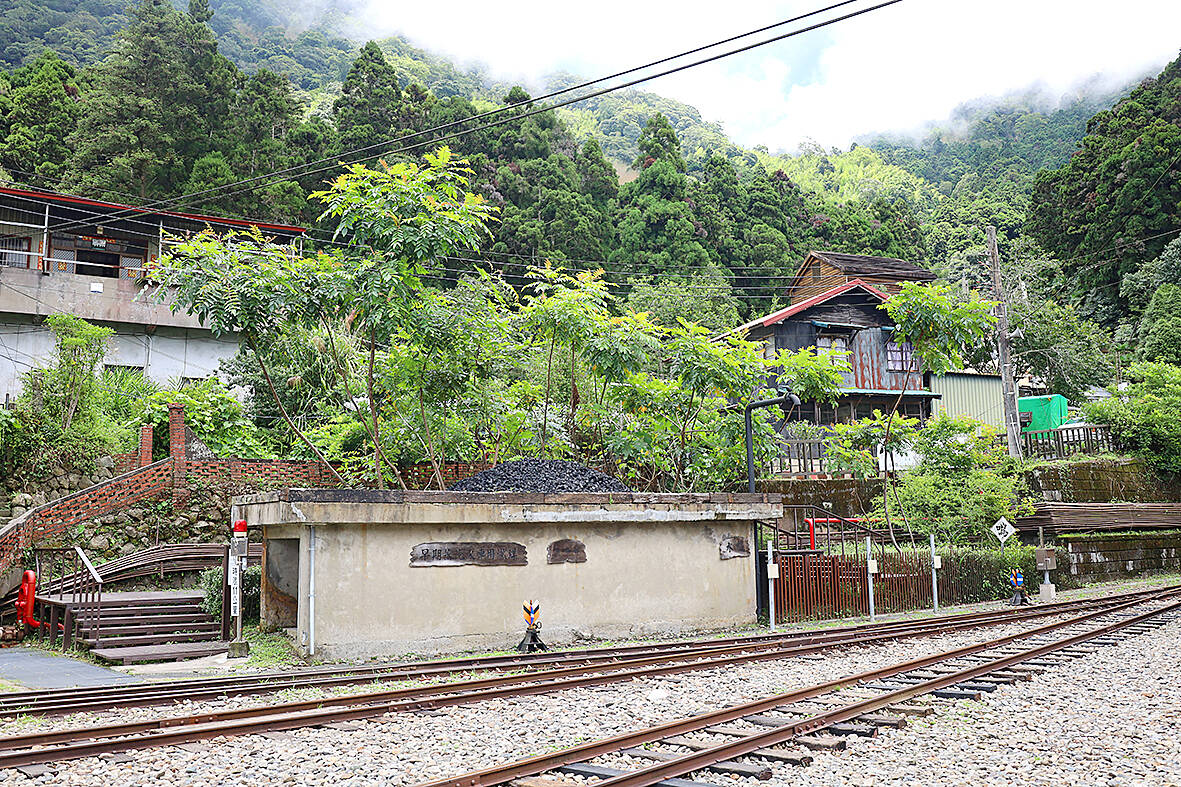The tropic of cancer bisects the city of Chiayi (嘉義). The morning heat is, predictably, intense. But the sky is blue and hued with promise.
Travelers brave the heat to pose for photos outside the carriages lined up at the end of platform one. The pervasive excitement is understandable.
HISTORIC RAILWAY

Photo: Thomas Bird, Taipei Times
The Alishan Forest Railway (阿里山森林鐵路) was engineered by the Japanese to carry timber from the interior to the coast. Construction began in 1906. In 1912, it opened to traffic, although the line has been lengthened several times since.
As early as the 1930s, the line had developed a secondary function as a tourist novelty.
Logging officially ended in 1988, but the forest railway has remained popular among tourists.

Photo: Thomas Bird, Taipei Times
Today, the image of a red locomotive chugging through tree-coated highlands is splashed across everything from packets of oolong tea to biscuit tins.
Since 2009, however, it has been impossible to travel along the track’s entirety. Typhoon Morakot wrought destruction on Chiayi County. Landslides warranted extensive repair work and it wasn’t until July this year that the service reopened.
ON TRACK

Photo: Thomas Bird, Taipei Times
Carriages are snug — rows of two seats and one seat intersected by a narrow gangway. There’s a bathroom and air-conditioning but this is where luxury ends.
At 10am, we shunt into motion, rolling towards our first scheduled stop Beimen (北門).
The motion of the train — the track is only 762mm wide — waddles from side-to-side as if being towed by an ox.

Photo: Thomas Bird, Taipei Times
Ahead of each level crossing the horn bellows until we get to Chiayi Garage Park, where several decommissioned trains and freight cars have been retired.
Groups of sightseers wave at us as we trundle past, as if we were celebrities.
Beyond Lumachan (鹿麻產), a woody Japanese-style stationhouse, the train rolls steadily past rustic farmhouses overlooking fields of waxy leaves cradling sweet Formosan pineapples.

Photo: Thomas Bird, Taipei Times
Turquoise-colored Jhuci Station (竹崎車站) marks the unofficial end of suburbia, as we cross a truss bridge and begin trekking towards the tree-studded mountains.
The genius for laying a narrow-gauge track zigzagging into near-vertical hills was lost once humankind entered the automotive age.
Nowadays, the bus takes little over two hours to get to Alishan. By contrast, the train takes almost five hours.
But as the old adage goes, “it’s about the journey, not the destination.”
All eyes are fixed on the windows when we begin snaking up an incredibly steep mountain face.
Our passage brings us into close company with towering cypresses enshrouded in mist, bringing to mind illustrations of the enchanted forest I’d loved as a kid.
Occasionally, serpent eagles are visible circling overhead. Distant Chiayi, too, is intermittently in eyeshot through forest clearings.
“We share the perspective of birds,” I write in my diary.
Somewhere past Dulishan (獨立山) the Alishan Express passes the 800-meter mark. A trackside sign indicates we’ve left “the tropical zone” and are now entering “the subtropical zone.”
We chug into the quaint mountain town of Fencihu (奮起湖) two hours after setting out.
As the train wheezes to a halt, passengers gasp and chatter, the prospect of lunch and a hilltop stroll seducing us one by one.
The weather is notably more alpine, the air scented with the perfume of plants.
MOUNTAIN HIGH
Since the Japanese founded the railway, “Fencihu has been the primary midpoint stop,” I read on a tourist sign. The town lays claim to having the highest “old street” in Taiwan at 1,405 meters.
This translates into what has become a tourist town par excellence.
Along Old Street, stores are piled high with local delicacies like mountain-grown wasabi and plum wine. A number of choice eateries have popped up catering to tourist traffic from both road and rail.
Once fed and watered, I conduct a quick tour of the locomotive shed located at the end of the tracks before heeding the train conductors whistle and rushing back for the remainder of the journey.
Our view is in constant flux. We pummel through tunnels — there’s a total of 50, notably tunnel 42, which has been decorated with an aboriginal flower motif — and clunk over wooden bridges.
We steer through thick woodlands and veer along the edge of mountain precipices in view of high-altitude tea plantations.
At over 2,000-meters above sea level, the train makes the first of three switch backs as it follows an Z-shaped route through the mountain forest.
Passing Sacred Tree Station (神木站) we roll into Taiwan’s pre-eminent mountain resort town right on schedule, alighting just before 3pm.
THE SUNRISE EXPRESS
Alishan Station is located at the heart of Alishan Forest Recreation Area, so all the amenities one might expect to find — a visitor information center, a post office, even a branch of 7-Eleven — are in close proximity.
Forest trails fan out from the station forecourt leading to various scenic points and there’s plenty of time for an afternoon hike.
But this is not the end of the line.
To complete the railway, one must shake themselves awake the following morning to catch the train to Chushan Station (祝山車站), a further three kilometers away.
Departure times change daily. Mine leaves at 4.20am.
At an elevation of 2,451-meters above sea level, Chushan has the highest altitude of any railway station in Taiwan. But that’s not why people get out of bed at an ungodly hour.
The train deposits passengers right outside a viewing point.
It is cold at this hour, and dark too. An eerie quiet is maintained amongst the crowd.
Change is incremental, as black becomes purple by degrees. Birdsong pipes up just before the sun is revealed, hidden behind a mountain, it beams, glorious, across the Formosan rooftop.

This month the government ordered a one-year block of Xiaohongshu (小紅書) or Rednote, a Chinese social media platform with more than 3 million users in Taiwan. The government pointed to widespread fraud activity on the platform, along with cybersecurity failures. Officials said that they had reached out to the company and asked it to change. However, they received no response. The pro-China parties, the Chinese Nationalist Party (KMT) and Taiwan People’s Party (TPP), immediately swung into action, denouncing the ban as an attack on free speech. This “free speech” claim was then echoed by the People’s Republic of China (PRC),

Exceptions to the rule are sometimes revealing. For a brief few years, there was an emerging ideological split between the Democratic Progressive Party (DPP) and Chinese Nationalist Party (KMT) that appeared to be pushing the DPP in a direction that would be considered more liberal, and the KMT more conservative. In the previous column, “The KMT-DPP’s bureaucrat-led developmental state” (Dec. 11, page 12), we examined how Taiwan’s democratic system developed, and how both the two main parties largely accepted a similar consensus on how Taiwan should be run domestically and did not split along the left-right lines more familiar in

Most heroes are remembered for the battles they fought. Taiwan’s Black Bat Squadron is remembered for flying into Chinese airspace 838 times between 1953 and 1967, and for the 148 men whose sacrifice bought the intelligence that kept Taiwan secure. Two-thirds of the squadron died carrying out missions most people wouldn’t learn about for another 40 years. The squadron lost 15 aircraft and 148 crew members over those 14 years, making it the deadliest unit in Taiwan’s military history by casualty rate. They flew at night, often at low altitudes, straight into some of the most heavily defended airspace in Asia.

Many people in Taiwan first learned about universal basic income (UBI) — the idea that the government should provide regular, no-strings-attached payments to each citizen — in 2019. While seeking the Democratic nomination for the 2020 US presidential election, Andrew Yang, a politician of Taiwanese descent, said that, if elected, he’d institute a UBI of US$1,000 per month to “get the economic boot off of people’s throats, allowing them to lift their heads up, breathe, and get excited for the future.” His campaign petered out, but the concept of UBI hasn’t gone away. Throughout the industrialized world, there are fears that